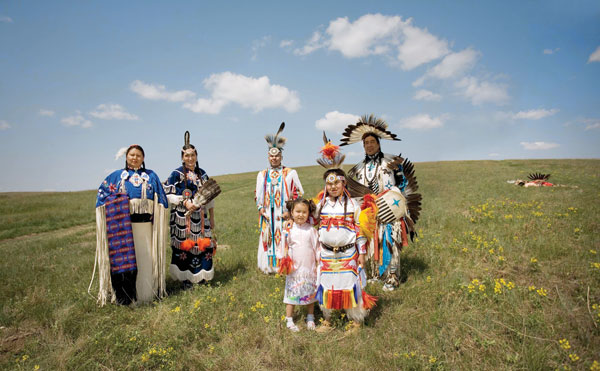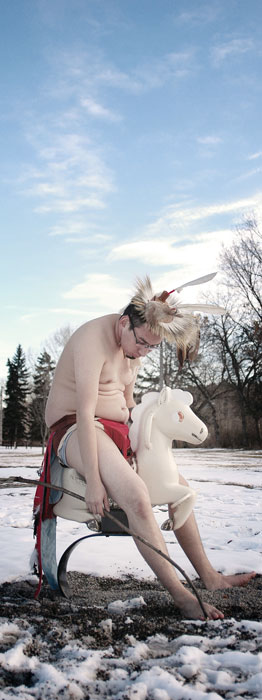[Spring/Summer 2011]
Terrance Houle
GIVN’R
Art Gallery of York University, Toronto
September 15 to December 5, 2010
At the opening for Terrance Houle’s solo show “givn’r” last September, most people mingled in the foyer of the Art Gallery of York University. Sure, it was where the free wine and cheese could be safely consumed, but it also felt strangely appropriate for Houle, a Calgary-based artist from the Blood Tribe in southern Alberta, whose performances are done primarily outside the gallery.
The travelling exhibition, curated by Antony Kiendl at the Plug-In ica in Winnipeg, includes Houle’s performance documentation, video works, and photographic series from the past decade. Often collaborative, his pieces use humour, narrative, and public intervention to confront assumptions about First Nations contemporary identity, Canadian colonial history, and cultural stereotypes. His work is grounded in summers spent with his paents following the pow-wow trail, where he learned the power of performance and of the relationship between performer and audience.
The first work in the show, Portage (2007), exemplifies all of these concepts. Houle and his friend, Métis artist Trevor Freeman, dressed up in traditional costumes – Houle in his loincloth and Freeman in a Métis outfit – and carried a canoe through the streets of various Canadian cities from one urban water feature to another. Video documentation of the Calgary and Toronto performances is on display for “givn’r,” and gallery visitors watch the footage of the two artists negotiating their way through the crowded city streets, noticed or ignored, laughed at or questioned. City sidewalks were a consciously chosen stage for the performance, not only as a public space indicative of contemporary life, but also for the artists’ chosen audience (rather than the other way around). The unsuspecting crowds became participants in the work, a position that cannot be extended to the viewing of the video documentation in the gallery. In an interview during the installation of the show, Houle told me, “I had one guy in Vancouver go, ‘You guys are just like in my Grade 10 textbook!’ And we’re like, ‘Yes! He got it! One person got it!’” This reaction to the absurdity of such a sight is necessary for the performance. How does this change within the context of its display in a gallery exhibition? Here, there is potential for Houle and Freeman’s intentions to be diluted. In an attempt to minimize this inevitability, Emelie Chhangur, assistant director and curator of the agyu, installed all of Houle’s performance footage in the foyer to be as much outside the gallery as possible.
The interior gallery space was filled primarily with what Philip Auslander calls “performed photography”1 – performances that exist solely as documentation. In video and photographic works such as The Metrosexual Indian (2005), Urban Indian Series (2004), and Landscape (2008), Houle performs playful variations on the “Indian-ness” made familiar through problematic high-school history textbooks and Hollywood films. Whether Houle is dressed in a simple loincloth or in the full, colourful pow-wow regalia of the Crow Hop, his performances are simultaneously funny and tragic narratives of how an identity is constructed and projected for oneself and others. According to Auslander, this kind of theatrical performance documentation “has no meaningful prior existence as autonomous events.”2 Yet, when I talked with Houle, the stories about making these performances dominated our conversation, and I realized that this aspect of the work adds another layer of meaning, challenging expectations of the genre.
In the video work Landscape, for example, Houle performs a chase scene in a field. It concludes with a climactic fall resulting in his tragic defeat, closely followed by the viewer’s realization that his pursuer is a little girl dressed in a pink cowgirl costume. Houle laughed as he told me about convincing his daughter to give him a kick while he lay in their front yard, about the bruises he endured from rehearsals, and about deciding to wear his modern glasses with his traditional costume. For the audience, it is an unexpected choice, one that was borrowed from watching his father Pow-wow dancing in aviator sunglasses.
In Landscape, their very presence subverts the assumption that the contemporary accessory is assumed to be out of place. This seemingly innocuous anecdotes about the preparation and actual performance speak to a larger exploration of the “performed” Indian identity that is expected from a contemporary urban Aboriginal male, something that is integral to Houle’s artistic project and everyday life.
Inside or outside the gallery, Houle’s performances raise many questions for the audience. Importantly, however, they do not provide any clear answers. “I’m speaking about the issue,” he told me adamantly, “and allowing people to walk away with whatever resolution they want to make. It’s not my duty to dictate to them, because I hate being dictated to!” Way to givn’r!
2 Ibid., p. 2.
Fiona Wright is currently completing her master’s degree in art history at York University, where her research focus is Canadian photography and First Nations contemporary art. She has worked as an independent curator in Toronto and Montreal, and will be co-curating the group exhibition “Cul-de-Sac” at the Varley Art Gallery in Unionville this summer.


